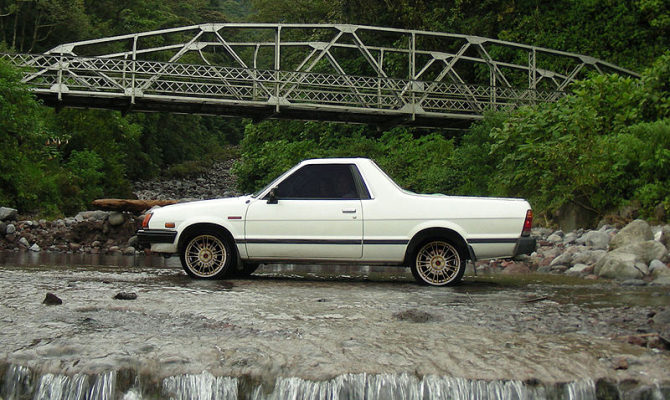“There’s a huge incentive for auto manufacturers to try to introduce unique trucks in an effort to expand their existing model lines and fatten corporate treasuries.”






by Larry Pintz
Over the past two decades, America has become a land of truck drivers as SUVs, crossover SUVs, minivans and pickups have grown to account for the majority of light vehicle sales in the United States. In fact, the most popular vehicle in the world for more than three decades has been the Ford F-150, which, according to Morgan Stanley, accounts for 90 percent of Ford Motor Company’s global profits.
Given that kind of profit margin, and considering that in a typical year 16 million new vehicles are sold, there’s a huge incentive for auto manufacturers to try to introduce unique trucks in an effort to expand their existing model lines and fatten corporate treasuries.
For the most part, these efforts succeed. Neither a Cadillac Escalade nor a BMW X5 seem as strange as they did a decade ago. But here are other efforts that seemed like a sure bet but somehow missed the mark.
1978 Subaru Brat/2003 Subaru Baja
The product plan: Chevy was reaping fat profits with its rear-wheel-drive, midsize, car-based El Camino, as was Ford with the Ranchero. Subaru took the plunge with the four-wheel-drive Brat. The carmaker repeated their folly with the 2003 Baja.
So what happened? Brat stood for “Bi-drive Recreational All-terrain Transport.” Based on the company’s compact sedan platform, the Brat’s practicality was limited by two rear-facing seats mounted in the cargo bed, which offered little protection from weather or accidents. The Baja was a similar effort, minus the cargo bed seats.
1982 Dodge Rampage
The product plan: Like Subaru, Dodge eyed the fat profits made by Chevy and Ford with their car-based pickup trucks and designed the Rampage to fill the void. Unlike the Subaru, there were no chairs in the cargo bed.
So what happened? In light of the second Mideast oil embargo, Dodge converted their product line to front-wheel drive. So, the Rampage was built on a compact, front-wheel-drive car platform with four-cylinders. However, domestic buyers expected their trucks to have eight cylinders. Result? – This tiny truck’s name was a ruse.
1989 Dodge Dakota Convertible
The product plan: Since truck buyers increasingly use their vehicles as lifestyle accessories, why not offer the ultimate four-wheel fashion accessory, a convertible pickup?
So what happened? You have to admire then-Chrysler CEO Lee Iacocca and crew for offering something that had never been tried. Nevertheless, whether bought for image or utility, trucks have to look as is they’re ready to work. By contrast, droptops must look seductive. The Dakota offered neither.
2001 Pontiac Aztek
The product plan: Design a car-based crossover SUV with Pontiac design cues hung on a minivan platform to give the vehicle a sense of excitement while saving development costs. Then, name it after a dead civilization, but misspell the name.
So what happened? This is a car that made sense only inside the airless world of GM’s numerous corporate committees. That said, the Aztek has one interesting idea: the center console doubles as a removable cooler. Other ideas, such as the optional tent, were regrettable. And need we mention the styling?
2002 Lincoln Blackwood
The product plan: Casting a jealous eye at the success and profitability of the Cadillac Escalade, in reality little more than a leather-lined Chevrolet Tahoe, Lincoln did the same to its bestselling Ford F-150 pickup.
So what happened? At the time, Ford’s CEO, Jacques Nasser, didn’t fully understand the American market, which might explain why the cargo bed was lined with carpet. Even worse, the cargo bed cover was permanently attached; so it was better at hauling polo mallets than cargo pallets. Ford lost millions on this truck.
2004 Chevrolet SSR
The product plan: Chevy unleashed this convertible pickup concept truck at the height of Detroit’s obsession with retro styling. It elicited such a positive reaction at auto shows that Chevy chose to build it. Given Chevy’s lineup at the time, it’s no wonder.
So what happened? The old saw about those who do not learn from history being doomed to repeat it applies here. While the SSR looked better than the Dakota convertible, its miniscule 4-foot cargo bed rendered the truck useless. Toss in lots of chassis flex and a lofty $40,000-plus price tag, and its fate was assured.
Larry Pintz writes for Hagerty, the world’s leading specialist provider of classic car and boat insurance. Learn more at hagerty.ca.
Recent Comments
- { Enjoyed your Forest of Bowland in the BMW X5M, particularly the photo of the BMW in front of the main part of Stonyhurst College where... }
- { Bantam designed the Jeep, not Willy's or Ford. The American military gave the original Bantam prototype to Willys and Ford to copy. There is plenty... }
- { All Escalades come with a 6.2-lilter V8 engine that produces 420 horsepower. A six-speed automatic is the only transmission offered and drives the rear wheels.... }
- { Alexandra is an excellent journalist. }
Popular Posts
- Journey to a ‘Sparkling’ Luxury Okanagan Resort “Four lucky readers will put a Dodge Journey’s weekend-...
- The Need For Speed: Hike Those Highway Limits More than half of those polled believe the province sho...
- Drives-U-Crazy… Erratic drivers. An early morning drive from Kelowna to Vancouver is nor...
- Readers Respond: The Pros and Cons of Increasing B.C. Speed Limits Increasing the speed limits will only increase risk to...
- Honda CR-V Review: The Compact Crossover To Get Things Done The CRV is a very stylish and aerodynamic crossover veh...






